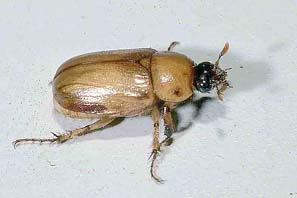White Grubs | |
|---|---|
| July 10, 2008 | |
|
Typically, by the end of the first week of July we are able to make some predictions on white grub infestations of turfgrass. However, not only are Japanese beetle adults emerging late and slowly, but also we have not seen any masked chafer emergence yet. Apparently, the cool spring soil temperatures have delayed emergence of all three species. The northern and southern masked chafer adults typically emerge in central Illinois around July 2 or 3, emerging a few days before that in southern Illinois and a few days after that in northern Illinois. In addition, reduced rainfall in June has sent non-irrigated turf into dormancy by early July in most years. In those instances, even a modest Japanese beetle and masked chafer adult emergence results in a high number of eggs being laid in irrigated turf, which causes severe feeding damage in August and September. However, the heavy rainfall that most of Illinois has experienced in the spring has kept much of the turf green and actively growing even though some areas have had little or no rain for 3 weeks. Predicted rainfall before and over the July 4th weekend should keep unwatered turf green and growing. In those situations, the beetles lay their eggs over large areas of turf, typically resulting in few white grubs per foot square and little turf damage later in the year. We should be able to determine over the next couple of weeks whether grub damage will be likely, based on beetle numbers and rainfall. The delayed emergence of adult Japanese beetles and masked chafers should allow more time to apply grub-control insecticides such as imidacloprid (Merit) and halofenozide (Mach 2). We normally recommend application during July, but we should be able to extend that into early or mid August this year. | |
| Author: | Phil Nixon |

